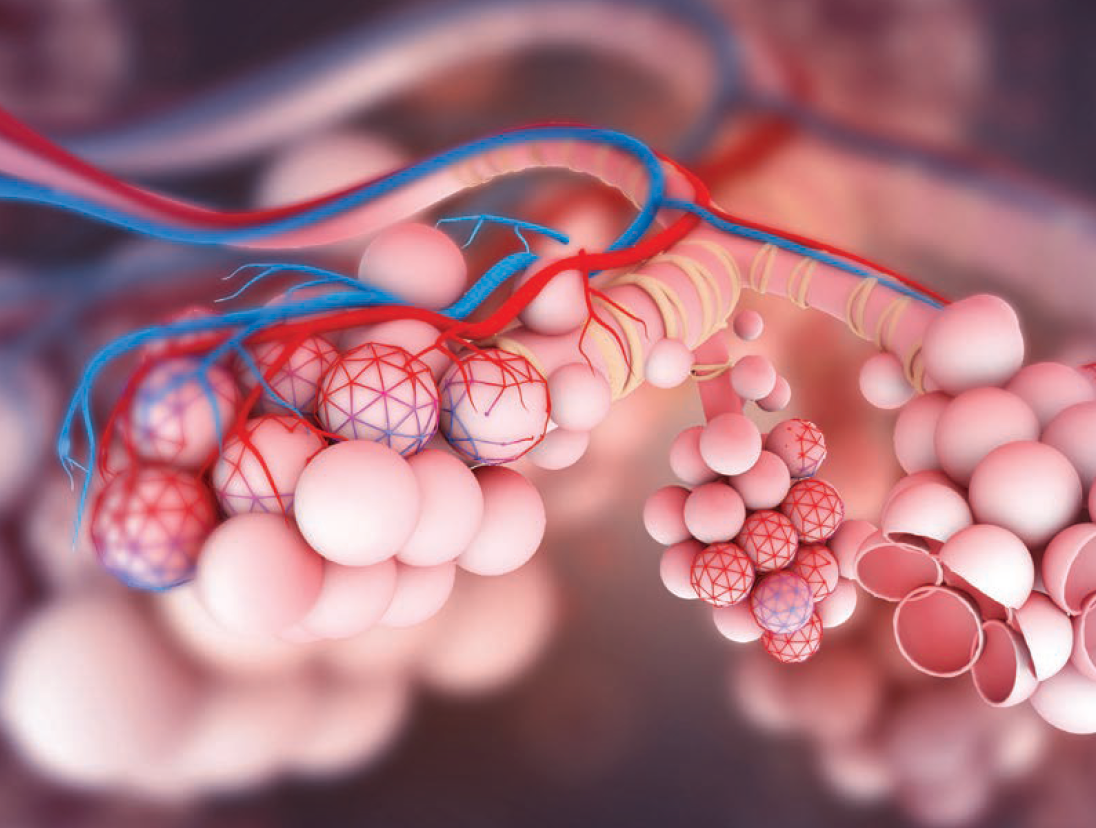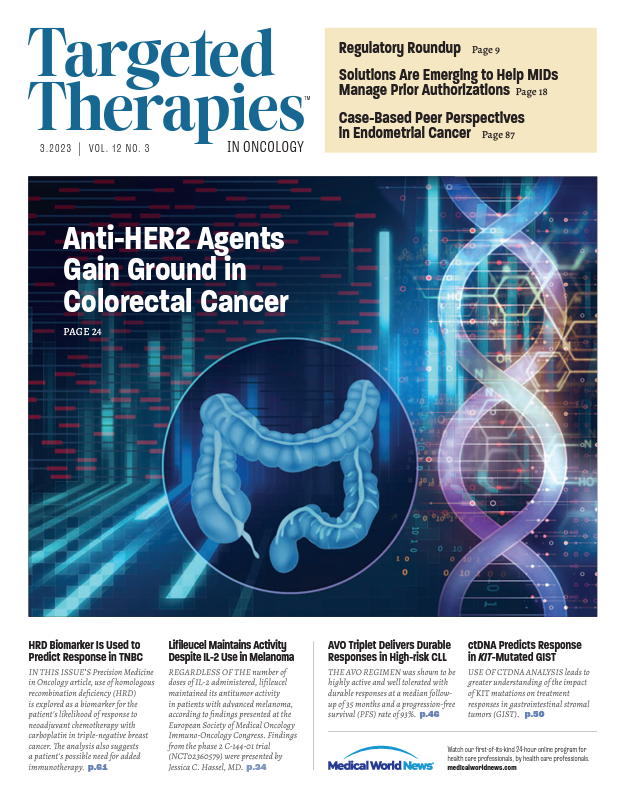Responses, Increased Resectability Are Observed With SHR-1701 in NSCLC
Phase 2 findings support a phase 3 investigation of neoadjuvant SHR-1701 as combination therapy for untreated stage III unresectable non–small cell lung cancer.

Findings from a phase 2 study (NCT03774979) evaluating the novel fusion protein SHR-1701 demonstrated that the agent induced responses in the majority of patients with stage III unresectable non–small cell lung cancer (NSCLC) and increased resectability in patients who were assigned definitive surgery.1 SHR-1701 is undergoing evaluation in China with Chinese patients exclusively.
The trial sought to determine if neoadjuvant treatment with SHR-1701 with or without chemotherapy followed by surgery or radiotherapy led to antitumor activity. Results were presented at the European Society for Medical Oncology Immuno- Oncology Congress 2022.
The post-induction objective response rate (ORR) was 56.1% (95% CI, 46.2%-65.7%). After treatment completion, the response rate increased from 25% to 70.1% (95% CI, 60.5%-78.6%). The disease control rate (DCR) at the end of treatment was 92.5% (95% CI, 85.8%-96.7%) and comprised mostly partial responses and stable disease.
“Neoadjuvant SHR-1701 with or without chemotherapy followed by surgery or radiation therapy showed promising antitumor activity despite a relatively high proportion of patients with poor baseline disease characteristics,” said lead author Yi-Long Wu, MD, professor of oncology at Guangdong Provincial People’s Hospital, China.
Standard therapy consists of consolidation immunotherapy after concurrent chemoradiation. However, neoadjuvant immunotherapy with or without chemotherapy has previously shown evidence of tumor and nodal downstaging in resectable NSCLC. By increasing resectability, the addition of immunotherapy-based induction therapy to consolidation therapy may improve outcomes in stage III unresectable disease.
SHR-1701 targets PD-L1 and TGF-β. Ina phase 1 trial, SHR-1701 was effective and tolerable in patients with advanced cancers.
To be eligible for enrollment in the phase 2 trial, patients had to have unresectable stage III NSCLC, an ECOG performance status of 0 or 1, no prior systemic therapy or radiotherapy to the thorax, and no sensitizing EGFR or ALK alterations.
After screening, patients were stratified into 2 groups depending on PD-L1 expressionlevel. Those with a PD-L1 tumor proportion score (TPS) below 50% received 30 mg/kg of SHR-1701 plus 175 mg/m2 of paclitaxel and carboplatin at an area under the curve of 5 every 3 weeks for 3 cycles (arm A; n = 88). Patients with a PD-L1 TPS of 50% or greater were randomly assigned to SHR-1701 plus the same chemotherapy regimen every 3 weeks for 3 cycles (arm B; n= 9) or the same schedule of SHR-1701 alone (arm C; n = 10).
After assessment, patients proceeded to definitive surgery followed by SHR-1701 every 3 weeks or definitive radiation therapy administered at 60 Gy/30 fractions plus 30 mg/m2 of concurrent cisplatin followed by SHR-1701 alone. Treatment with SHR-1701 was continued for 16 cycles or until progressive disease or unacceptable toxicity.
The primary end points were post-induction response and event-free survival (EFS). Secondary end points included overall survival, time to distant metastasis, and safety. Major pathological response (MPR) and surgical rate were assessed as exploratory end points.
Median patientage was 59 years (range, 31-70), and most patients were male (n=101; 94.4%). Most patients had an ECOG performance status of 1 (n=71; 66.4%), squamous histology (n=79; 73.8%), stage IIIB (n=47; 43.9%) and IIIC disease(n=32; 29.9%), and a PD-L1 TPS below 1% (n=48; 44.9%) and
between 1% and 49% (n=40; 37.4%). Additionally, 89.7% (n=96) of patients were current or former smokers.
Additional findings showed that the combination of SHR-1701 and chemotherapy led to higher response rates compared with SHR-1701 alone. In arms A and B, the ORRs post-induction and after treatment completion were 57.7% (95% CI, 47.3%-67.7%) and 71.1% (95% CI, 61.0%-79.9%), respectively. The DCR was 92.8% (95% CI, 85.7%-97.0%). This compared favorably with the post-induction and end-of-treatment response rates of 40.0% (95% CI, 12.2%-73.8%) and 60.0% (95% CI, 26.2%-87.8%) in arm C, respectively. The DCR in this subset was 90.0% (95% CI, 55.5%-99.7%).
At a median follow-up of 11.8 months, the overall median event-free survival (EFS) was 18.2 months (95% CI, 11.8-not reached [NR]). In arms A and B, median EFS was 14.9 months (95% CI, 11.5-NR); in arm C, median EFS was NR (95% CI, 2.0-NR).
Notably, patients who underwent surgery did not reach the median EFS (95% CI, 11.8-NR). Those who received definitive radiation therapy achieved a median EFS of 14.9 months (95% CI, 11.4-NR). The 12-month EFS rates with surgery and radiation therapy were 74.4% and 55.9%, respectively.
“Benefits with induction treatment were partly conferred by allowing surgery conversion, with a conversion rate of 25.2% [n = 27/107],” Wu said, adding that conversions occurred in patients with stage IIIA (n = 10), IIIB (n = 12), and IIIC (n = 5) disease at baseline.
Additionally, among resected patients, the N2 and N3 downstaging rates were 57.1% (n = 8/14) and 66.7% (n = 6/9), respectively. Moreover, the MPR rate was 44.4% (n = 12) and the pathologic complete response rate was 25.9% (n = 7).
“Favorable efficacy was observed in resected patients, and [the overall] safety profile was tolerable, with no new safety signals identified,” Wu said.
Treatment-related adverse effects (TRAEs) that occurred in at least 15% of patients included white blood cell count decrease (68.2%), anemia (66.4%), neutrophil count decrease (64.5%), platelet count decrease (50.5%), decreased appetite (47.7%), alopecia (41.1%), nausea (38.3%), lymphocyte count decrease (37.4%), hypoesthesia (30.8%), asthenia (29.9%), rash (29.9%), alanine aminotransferase increase (29.0%), hypoalbuminemia (27.1%), vomiting (25.2%), aspartate aminotransferase (24.3%), hyponatremia (23.4%), pyrexia (17.8%), infusion-related reaction (16.8%), pruritus (16.8%), and pain in the extremity (15.0%).
Grade 3 or greater AEs (n = 84; 78.5%) and TRAEs (n = 77; 72.0%) occurred in most patients. SHR-1701 was the primary agent leading to treatment discontinuation in 15.9% (n = 17) of patients, followed by paclitaxel (n = 1; 0.9%), carboplatin (n = 1; 0.9%), and cisplatin (n = 4; 2.8%).
Immune-related AEs occurred in 57.0% (n = 61) of patients, and 3 deaths occurred.
“Our data support phase 3 investigation of neoadjuvant SHR-1701 as combination therapy for untreated stage III unresectable NSCLC,” Wu concluded.
REFERENCE:
1. Wu YL, et al. A phase 2 study of neoadjuvant SHR-1701 with or without chemotherapy (chemo) followed by surgery or radiotherapy (RT) in stage III unresectable NSCLC (uNSCLC). Presented at: ESMO Immuno-Oncology Congress 2022; December 7-9, 2022; Geneva, Switzerland. Presentation LBA5.
